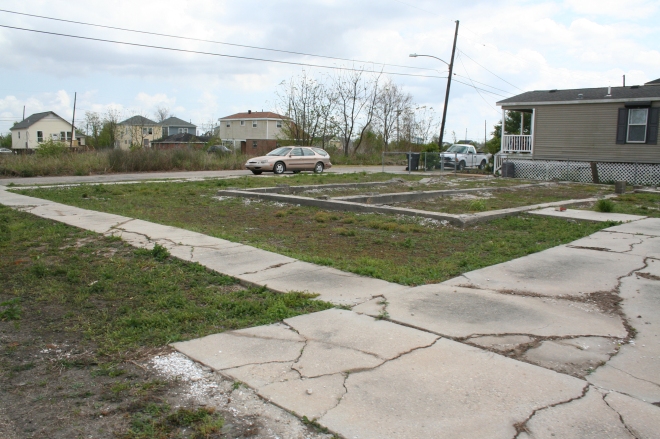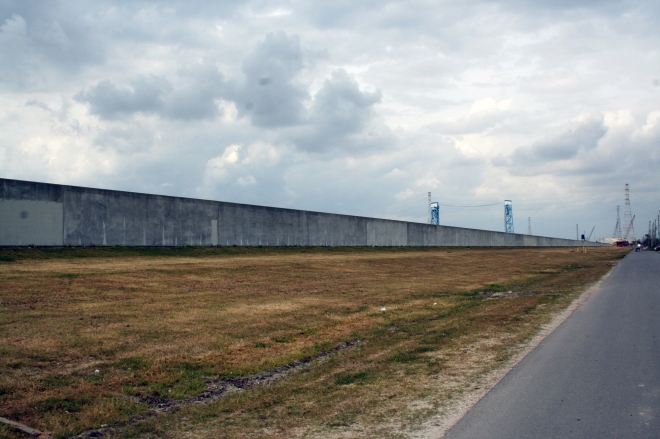You make your way down Florida Avenue to the east towards the Industrial Canal – that man-made boundary and connection that both guards the Lower Ninth Ward from the part of New Orleans that pulls the most tourists and connects the Lake to the Mississippi River. Your route is flanked by railroad tracks and depots, and desolation on either side as you pass slouching houses opening onto grand weed-strewn lots.
An overpass appears in the distance, some intricate graffiti ebbs along concrete blocks, and you’re surrounded by a deafening echo from traffic overhead. Rows and rows of concrete columns support the massive highway, shrinking into the darkness on either side.
You’re biking along cracked roads with infrequent traffic passing on your left, trying to keep up with your friend whose been touring you through the richest and most desolate parts of New Orleans. So today you requested a trip to the Lower Ninth Ward, and this particular route takes you on a few unexpected detours.

You take a sharp left over the railroad tracks and into a scarcely recognizable parking lot. Only the yellow paint marks make that clear. You’re led into an abandoned strip mall, turned venue, and you’re told – if you can imagine it among the corroding steel and cracking concrete – that it is sometimes host to a bar, a stage, a dance party. A car flipped on its back is the centerpiece that rests in the middle of one of these halls that was once a contribution to commerce in the city. Some punks set it ablaze – evidence of which is visible on the charred ceiling – during one of the shows.

If you can believe it, New Orleans breathes life into its own dilapidation. Something exhilarating happens between the cracks, vying for life with a new energy. You see it in the weeds, winding their way through concrete cracks, sprouting through the walls. You can fight it but in this particular circumstance it has been given free reign.
From the roof you can see far beyond the low-lying city in all directions. The streets are mostly quiet, a few kids ride by on bikes in the direction you came from. In the distance you see what passes for a public housing development. That is your next stop because, from here, something seems a bit off about the dark windows and the graffiti-scrawled facades.

The dozen or so, three-story multi-family homes look just about complete. As you approach the buildings, it becomes clear that the graveyard of foundations to your right, that span about a hundred yards, are not the broken remains of the demolished homes you’ve heard about and will soon see in the Lower Ninth. In a much starker reality, they are evidence of a floundering housing development that built these homes, never occupied, rotting since the storm. Maps indicate that it is the Florida Housing Development but no amount of research has yielded any results on the current status of the project, its past or its future.

Markings on the existing homes are assessed as too damaged for habitation, but you wonder about how much value these homes could have had in light of housing shortages after the storm if they had only been worked on. You consider the controversy of toxic FEMA trailers and wonder if this would have been a better option.
These questions are outdated. You are seeing this seven years hence and the tired old truths about government bureaucracy and housing and public money and funding and bankruptcy beckon explanation where none exists.

The houses, now covered in graffiti, stripped of windows, full of weeds look so close to completion whenever they were cared for last. The interiors appear finished with the last minute details of construction including paint and door handles and light fixtures. But doors are flung open and anonymous declares “if dese be projects, dey should be complete”.

You venture on. You’re now very close to the scrap yards that line the Industrial Canal and you pause as the gate lifts to allow a barge to pass through. No one else is around. Maybe a car or two pulls up to the arm of the drawbridge, waiting for the crossing. It only takes a few minutes but you soak up the sun because pretty soon the heat and humidity will be unbearable – you’ve been warned. You’ll drown in your own sweat from the unrelenting heat.
Over the bridge and Welcome to the Lower Ninth Ward.

At first it seems no different from the neighborhoods across the canal from which you just came. But you seldom encounter any streets that aren’t cracked, filled with dirt and sand, crumbling into potholes, or covered in weeds. At least here they are much more frequent. You are still in the city – this isn’t the back-country. But if you found yourself here with no context you could easily make that mistake. New Orleans isn’t particularly dense, but this place is sparse. And perhaps what makes it more poignant is that the city grid still peers through the weeds.
Throughout the rest of the city you had passed commercial hubs and corridors, industrial centers, dedicated zones of infrastructure and manufacturing. But out here, you have to be reminded that aside from the stigma of the Lower Ninth – crime and poverty that predates Hurricane Katrina – this was a neighborhood and a community. These were homeowners that visited Claiborne Ave, a main thoroughfare that was once a commercial corridor.
Today you’ll pass a gas station, a grocery store, the renowned taco truck and possibly a fried chicken vendor. Yet, as it exists, Claiborne still carries a steady stream of traffic heading east to west to east, out to the city or out to the swamp.

You turn in to any of the side streets and the silence is pervasive. Your tires rustle the dirt a bit, a light wind swishes the trees, but all around you is quiet. Occasionally you’ll hear the sound of men yelling orders and hammering because every once in a while there appears to be construction in progress.

The street names are still prominent, even when they no longer exist. Some are dead ends. In other words, some aren’t really streets anymore; they’ve been reclaimed by the weeds, overgrown and covered in brush. And the houses that once lined these streets? Well they’re gone and rarely does any evidence exist. In some cases, you’ll still see a concrete foundation holding out against the growing weeds, or scattered bricks once stacked as legs supporting an elevated house. There are even some concrete stairs leading up to nowhere. Along a few stretches of street someone spray-painted the house numbers or the lot numbers, whichever applies, on the concrete. More than likely, though, you’ll see nothing but vegetation and vastly unoccupied space.

This level of erasure, this expediency towards the dissolution of physical history is brutal. But again, seven years. So nature is reclaiming development. You wind your way through these endless streets, happen upon a friend of a friend’s farm, wonder about its legality, and move on.

Now you’re at the levee along Jourdan Ave – that broad concrete structure, the precariously engineered separation between the powerful forces of the Mississippi River and its tendency to surge and reclaim land. The levee – a bare concrete form – is reminiscent of a sense of confinement and a chilling reminder of why this needs to be here. If you live across the street from this thing you’re facing a wall from which a few of the drawbridges over the Industrial Canal peak out. Someone should graffiti this thing.

Then you start to approach the contested project of Make It Right – a program founded by Brad Pitt to bring quality housing back into the hands of the displaced residents of the Lower Ninth Ward. These bright homes, covered in solar panels, are readily distinguishable from the rest of the neighborhood.
Let’s review. You’ve passed one story chicken-leg homes carried on stilts about eight feet off the ground. You passed pre-flood homes marked with X’s, dates and notes by first responders assessing the damaged structures and looking for survivors a few weeks after the Hurricane. These were low-lying one-story houses now with boarded up windows of modest wood or brick construction. You passed the ranch style houses, kids playing out front, pick up trucks parked on lawns, some rattling with music for Easter Sunday festivities. None of them are much taller than two stories until you hit Make It Right.
The Make It Right homes are clustered in a four-block radius with tree-lined streets, mowed lawns, and decorated porches. The streets are maintained and although this too has low density, it feels more like a neighborhood than any other part of the Lower Ninth. People are out hanging out on the stoops, barbecuing and playing music, and laughter and conversations make an impression on the street. People nod hello as you pass.
If you were interested in the architecture, you would mind the design of these homes and consider their innovation. Pitched roofs are mounted with solar panels to optimize sun absorption, you assume, and to facilitate air circulation. You would notice carports below the homes raised well above the first story level to be protected against any water that may come that way in the future. You would see how the homes are carved out of function – exterior terraces, exterior stairs, open air balconies and translucent walls.

But the value here reaches far beyond these observable form and function nuances. You’ve read that the materials are durable, ecologically sound, and that construction is designed to address the failures witnessed in previous hurricanes. But all that aside, the neighborhood is being rebuilt and we can argue about how far Make It Right goes, whether these particular homes are worth the millions of dollars already spent over the past five years. What matters more is that people are returning by some margin. And yet, the Lower Ninth Ward, for all its negative attention, is still just a neighborhood – extreme by all accounts – but certainly not alone in New Orleans.





















